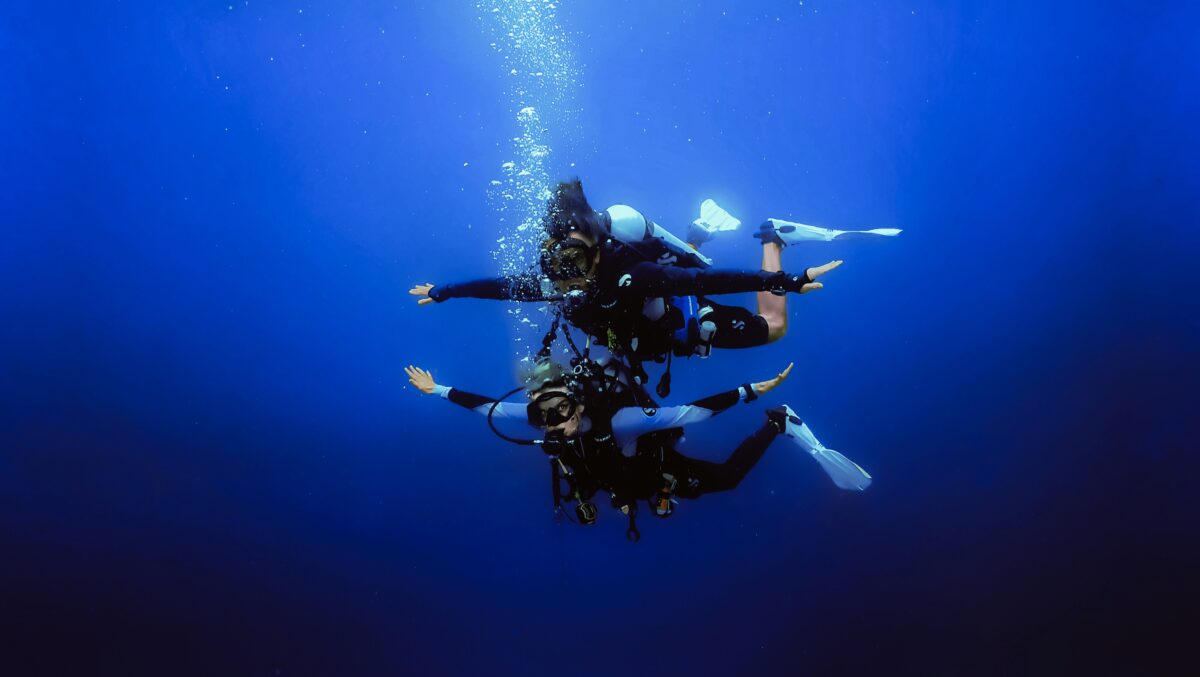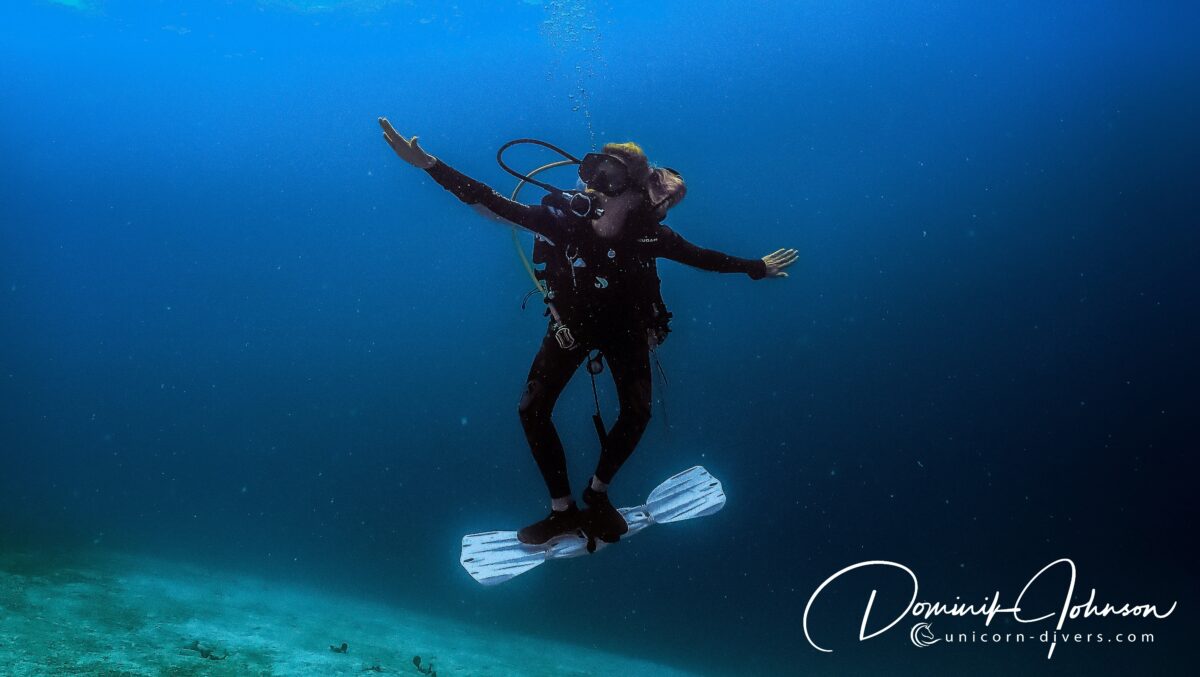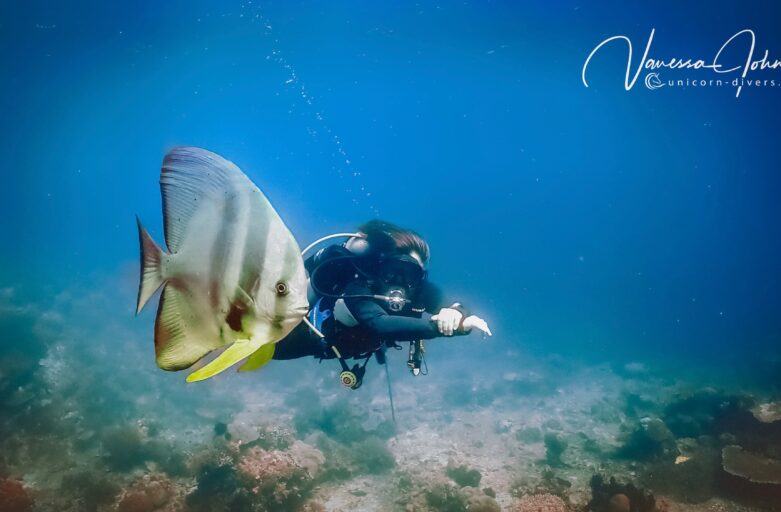Scuba diving is a breathtaking adventure that allows us to explore the mesmerizing underwater world. While diving, one of the fundamental skills every diver should master is neutral buoyancy. Achieving neutral buoyancy in scuba diving is like performing a magic trick underwater. It’s the art of floating effortlessly in the aquatic realm, almost defying gravity. In this article, I’ll unveil the secrets of neutral buoyancy, explaining what it is and how to achieve it using three essential techniques: proper breathing, weight management, and relaxation.
Do you know what the very first thing we did in our very first dive theory class was? Breathe!
Our instructor let us breathe. For 5 minutes. Then another 5 minutes. We sat at the table, wanting to learn all about diving – and we breathed first.
Why? Because breathing properly is the biggest and most important secret to your diving adventure. When you master your breath underwater, the true magic that the underwater world has to offer is revealed to you on every dive.

What is Neutral Buoyancy in Diving?
Neutral buoyancy is a state where an object, in our case, a scuba diver, hovers in the water without sinking or floating. Achieving neutral buoyancy means finding the perfect balance between the forces of gravity pulling you down and buoyancy pushing you up. When you attain neutral buoyancy, you can effortlessly glide through the water, conserve energy, and minimize your impact on the delicate underwater ecosystem that we all love.
Neutral buoyancy is crucial for several reasons:
- Safety: Maintaining neutral buoyancy helps prevent accidental collisions with the seafloor or coral reefs, reducing the risk of injury and damage to marine life.
- Conservation: It ensures that divers minimize their disturbance to fragile aquatic environments, preserving them for future generations.
- Efficiency: Neutral buoyancy conserves energy and extends dive time, allowing divers to explore longer and more comfortably.
- Photography and Observation: It enables underwater photographers and marine biologists to capture clear, stable images and observe marine life without causing disruption.
Dive formula for achieving neutral buoyancy underwater
The dive formula for achieving neutral buoyancy underwater primarily involves understanding the principles of buoyancy, weight, and displacement. And yes, it’s physic – but it’s not annoying, because it’s about diving, right geeks?
While there isn’t a specific mathematical formula like you might find in physics equations, there are fundamental concepts and calculations that divers use to achieve neutral buoyancy.
Here’s a simplified explanation of these concepts:
- Buoyancy Force (B): This force is what keeps objects afloat in water. It’s the force exerted by the water on an object, pushing it upward. The formula for buoyancy force is:
B = Weight of Water Displaced.
To achieve neutral buoyancy, the buoyancy force (B) must be equal to the weight of the object.
- Weight of the Diver (W): This is the force exerted by gravity on the diver and all their equipment. It includes the weight of the diver’s body, scuba tank, gear, and weights. The formula for the weight of the diver is:
W = Mass x Gravitational Acceleration (W = m * g)- Mass (m) is the total mass of the diver and equipment.
- Gravitational Acceleration (g) is the acceleration due to gravity, which is approximately 9.81 m/s² on Earth.
- Buoyancy Control Device (BCD): Divers use a BCD to control their buoyancy. By inflating or deflating the BCD, the diver can adjust their buoyancy. When the BCD is inflated, it increases the volume of the diver, and when it’s deflated, it decreases the volume.
To achieve neutral buoyancy, divers aim to make the weight of the diver (W) equal to the buoyancy force (B) by adjusting the amount of air in the BCD and the amount of weight they carry. The specific calculations and adjustments vary from dive to dive and depend on factors like water density, the diver’s body composition, and the equipment used.
In practice, achieving neutral buoyancy involves a combination of:
- Adjusting the amount of air in the BCD to control ascent and descent.
- Adding or removing weight as needed.
- Fine-tuning buoyancy by controlling breathing and body position.
It’s important for divers to gain experience and practice to develop a good sense of buoyancy control. We often teach and guide divers in mastering these skills, and divers typically go through buoyancy control drills during their training.
While there isn’t a single formula for neutral buoyancy, understanding the principles of buoyancy, weight, and displacement, as well as gaining practical experience, are essential for divers to achieve and maintain neutral buoyancy effectively.

How to Achieve Neutral Buoyancy in Scuba Diving
Now that we understand the importance of neutral buoyancy let’s delve into the three magic secrets of achieving it: proper breathing, weight management, and relaxation.
1. Breathing
Proper breathing is the foundation of neutral buoyancy in scuba diving. When you breathe, you control your buoyancy. Here’s how:
- Slow and Deep Breaths: Practice slow, deep breaths, inhaling and exhaling steadily. Avoid shallow, rapid breathing, which can cause fluctuations in buoyancy.
- Use Your Lungs: Adjust your buoyancy by inflating or deflating your buoyancy control device (BCD) as you breathe. Inhale to ascend, exhale to descend.
- Practice Buoyancy Control Drills: Work on your buoyancy control during training sessions, focusing on maintaining a steady position in the water column using your breath.
2. Weight
Weight management plays a crucial role in achieving neutral buoyancy. Too much or too little weight can make it challenging to stay neutrally buoyant. Here’s how to get it right:
- Perform a Weight Check: Before every dive, conduct a weight check to determine the right amount of weight to carry. This involves floating at the surface with a full tank of air and adjusting your weight until you are eye-level with the water.
- Use Less Weight: Aim to use the minimum amount of weight necessary. Carrying excess weight requires more effort and air consumption to stay buoyant.
3. Relaxation
Relaxation is the secret ingredient that ties everything together. Tension in your body can lead to erratic movements and difficulty achieving neutral buoyancy. Tension in your body even can lead to panic underwater.
During the dive, consciously focus on the different areas of your body that are tense: Neck, arms, legs, back? Try to relax them consciously. Follow these relaxation techniques:
- Mental Calmness: Stay calm and composed underwater. Panic or anxiety can disrupt your buoyancy control.
- Streamline Your Gear: Minimize dangling equipment and streamline your dive gear to reduce drag and make movements smoother.
- Practice Yoga and Meditation: Engaging in relaxation techniques like yoga and meditation outside of diving can help you stay relaxed and focused underwater.
- Buoyancy Check: Periodically check your buoyancy during the dive to make minor adjustments, ensuring you remain neutrally buoyant.
In conclusion, mastering the art of neutral buoyancy in scuba diving is like uncovering the secrets to an incredible underwater experience. It’s a skill that takes time and practice but pays off in terms of safety, conservation, and enjoyment of the aquatic world. Remember the three magic secrets: proper breathing, weight management, and relaxation, and you’ll be on your way to becoming a buoyancy magician in the depths of the ocean. Happy diving!
If you’re interested in learning more about neutral buoyancy diving or have any questions about scuba diving techniques, feel free to reach out to me. Dive safely and responsibly, and let the magic of the underwater world amaze you!

